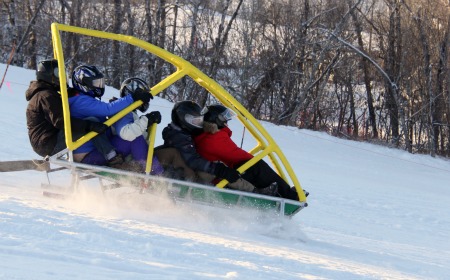
The 2016 UAlberta GNCTR team gets speed as it tests its sled prior to competition.
(Edmonton) A student group taking engineering and tobogganing to the extreme is competing against students from across the country this week at the Great Northern Concrete Toboggan Race championships in Ottawa.
Based in the Department of Civil and Environmental Engineering, the University of Alberta Great Northern Concrete Toboggan Race team designs and builds a 300-lbs. concrete toboggan for the national competition, applying engineering knowledge to a fun, real-world challenge.
The event has its roots in the 1970s when U of A engineering students adapted a popular concrete canoe competition held in the U.S. The rules are simple: toboggans must weigh no more than 300 lbs., and all surfaces touching the snow must be made of concrete. The sled must be able to safely accommodate five occupants. Teams are judged on multiple categories, the most spectacular being the races. Teams hitting the highest speed and stopping in the shortest distance earn the most points.
Team captain Steven Parth, a fourth-year mechanical engineering (co-op) student, says this year's team is giving it all they've got, from concrete and structural design to costumes.
For starters, the team typically begins developing its mix of concrete by calling up senior engineers for advice. This year, the team was more self-reliant.
"This year we actually attempted to make our own base mix and work off of that, so we had to do different methods of our mix design," he said. "It was a lot more work for the concrete team this year. Some of those mixes they tried completely failed but they got it right in the end. They ended up doing a good job."
One key area teams are judged on is spirit and with this year's Cirque du Sleigh theme, the team's costumes are elaborate. Costumes team lead Amanda Fremmerlid led sewing bees in the ETLC atrium, with Fremmerlid providing her own sewing machines.
"I really love doing this kind of work," said Fremmerlid. "For me, the choice I had to make was between engineering and tailoring. I'm doing both right now, so I'm pretty happy."
The evening sewing sessions tended to draw attention.
"People were stopping by and asking what we were doing," said Parth. "It's a lot of work and it's a team-building thing. It's a big job. They're by far the most complicated costumes I've seen but Amanda is really talented and she loves to do both."
Students on the team say participating in hands-on engineering challenges enriches their engineering education, giving them experience in project management, and teaching them to come up with creative engineering solutions on-the-fly.
"There is no course that teaches you what to do when you break your toboggan two days before you're supposed to ship it half-way across the country," said Parth, alluding to a toboggan test run that went wrong just prior to the team heading to Ottawa.
Team member Greg Nieberding agrees that the experience of being on a team gives students real-world experience.
"You can go through your classes and learn all the technical stuff and learn how to design things, but when you have to design something and turn it into a physical item it's different," he said. "You come up with drawings and take it off to have it made and the guy will look at you like you have four eyes and say "Yeah-you can't do this." They make suggestions on how to improve your design and you get experience turning your designs into something tangible."
About 30 team members are making the trip to the competition, which runs Jan. 27 - 31.